Max leads F1's battle of the Americas in 2021
With quick-fire races across both the north and south continents, Red Bull still leads the way, but only just after some Hamilton genius in Brazil, says Mark Hughes
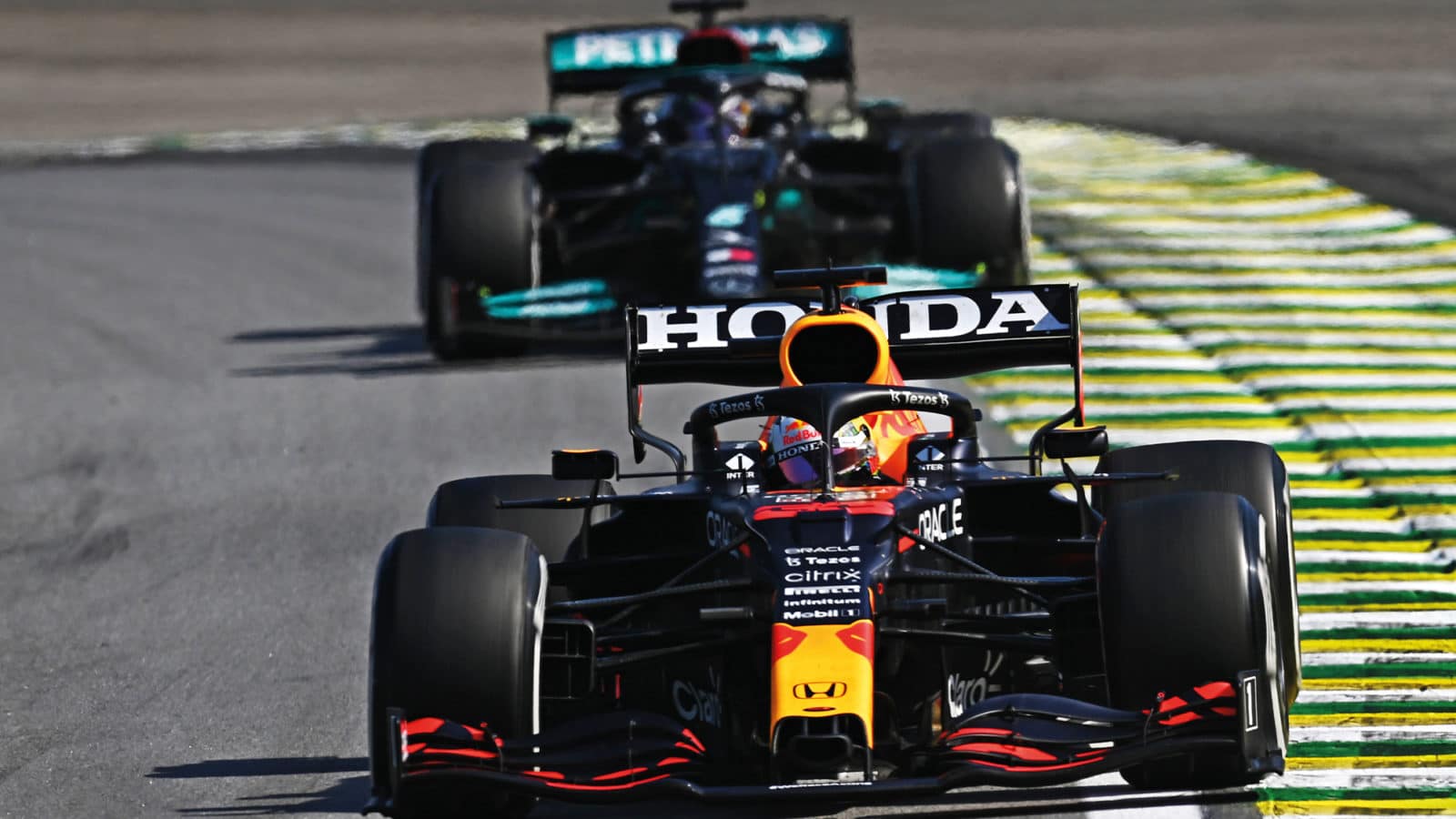
Verstappen and Red Bull were firmly shaded by Hamilton and Mercedes in Brazil. With three races left, Max leads by just 14 points
USA GP | Mexican GP | São Paulo GP
This three-race run, with just three more to go, put a very different complexion on the championship contest. Coming in, Max Verstappen was just six points clear of Lewis Hamilton whose Mercedes appeared to be in the ascendant. In Austin and Mexico that performance picture was turned on its head as Verstappen extended his lead to 19 points, comfortably beating Hamilton both times. With Mercedes down on performance, carrying an engine reliability concern and now many points down with not many races left, it wasn’t looking good. But a new powerunit for Brazil combined with the particular demands of the Interlagos track completely transformed those prospects and Hamilton delivered one of the most dazzling – and unlikely – victories of his long career. He left Brazil still trailing Verstappen by 14 points but very much back in contention in this remarkable seasonal narrative.
Things started well for Hamilton and Mercedes on the first day of running at Austin when Hamilton and Valtteri Bottas were 1-2 in first practice, well clear of Verstappen. But that picture flattered Mercedes and was simply a reflection of the engine mode sweeps the team routinely makes on Friday morning. With the Mercedes and Honda both on representative modes that afternoon, the comparison favoured Red Bull slightly. Further, the Mercedes seemed to be overheating its tyres more.
“Mercedes’ engine issue remains a serious concern for Hamilton”
That issue would turn out to be central to the whole weekend, for the Circuit of the Americas track was imposing massive thermal degradation on the rear tyres. Its layout places a big demand on the rears. As such, this has always been a thermal deg race, where the driver has to drive to his tyre temperatures at speeds whole seconds slower than he would otherwise be able to go. It was made worse this year by the bumps which had developed, particularly around Turn 8. The rapid compression and decompression of the sidewalls over bumps is a sure-fire way to add heat into the tyres.
So in the Mercedes/Red Bull battle this swung things towards the Red Bull, which is invariably better at controlling rear tyre temperatures. The difference was quite small but crucial. It was there in both qualifying and race, both of which distilled into the usual Verstappen vs Hamilton contest.

Verstappen won a cagey US Grand Prix, which hinged on tyre usage
The difference between the cars was on this occasion smaller than that between the lead and second drivers of each team. Valtteri Bottas was taking a grid penalty for his sixth Mercedes engine of the season, so making him less influential in this contest than Red Bull’s Sergio Pérez, who qualified third. That Mercedes power unit problem, understood to be a materials batch issue and afflicting the crankshaft/big ends, remained a serious concern for Hamilton’s title quest. His PU1 died in practice at Zandvoort, PU2 had reached its mileage limit, PU3 was the first to be affected with the materials issue and isn’t deemed fit to race. PU4 was introduced in Turkey but without an additional extra engine this would have to carry the burden of seven races. Furthermore, the Mercedes loses more performance with mileage than the Honda. It seemed certain Hamilton would be taking his fifth motor of the season somewhere.
But on race day at Austin, Hamilton burst into the lead at the start, refusing to be intimidated by Verstappen leaning on him heavily. This gave the race some tension as the slower car (on the day) was now in front of the faster one. Verstappen could easily stay with the Mercedes (at the tyre temperature-induced pace Hamilton was having to drive) but couldn’t pass it.
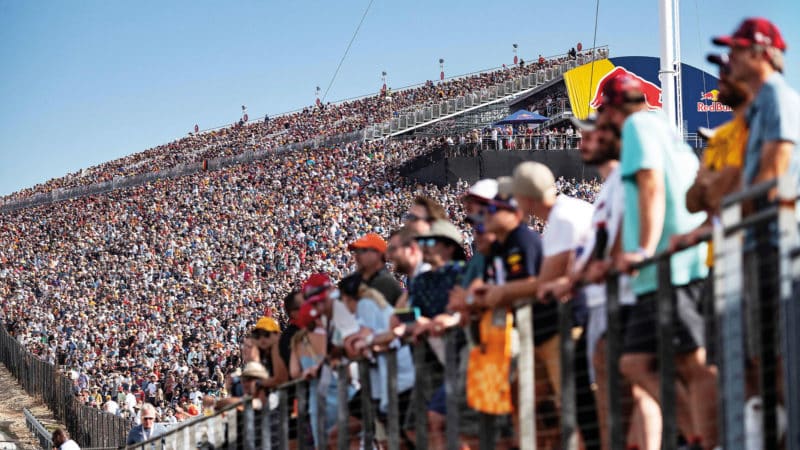
This year’s US GP broke crowd records with a reported 400,000 fans attending
The outcome of this race was going to be all about track position. Hamilton had taken it at the first stint of this two-stop race, Verstappen would take it going into the second stint as Red Bull pitted him aggressively early (see tactics). From there the faster car was in front but on a compromised strategy, with a lot of laps for the stint two and three tyres to cover. Hamilton on fresher tyres closed the Red Bull down in the last stint but had neither the speed nor the tyre grip to put a move on it. A very accomplished Verstappen victory, with Hamilton taking the point for fastest lap, extended the Red Bull driver’s lead in the championship to 12 points.
In Mexico two weeks later Red Bull’s underlying advantage was much greater than in Austin – but the team blew its qualifying in not reacting quickly enough to a change in track temperatures, allowing Mercedes to lock out the front row, Bottas this time ahead of Hamilton as he enjoyed the power boost of his fresher engine.
That was all rendered moot in the opening seconds of the race as Verstappen, helped by a tow from the two Mercs on the season’s longest run from the grid to Turn 1, flicked left and calmly out-braked them both to take the lead. Bottas was hit by Daniel Ricciardo’s McLaren and would have no bearing on the race other than to deprive Verstappen of the point for fastest lap.
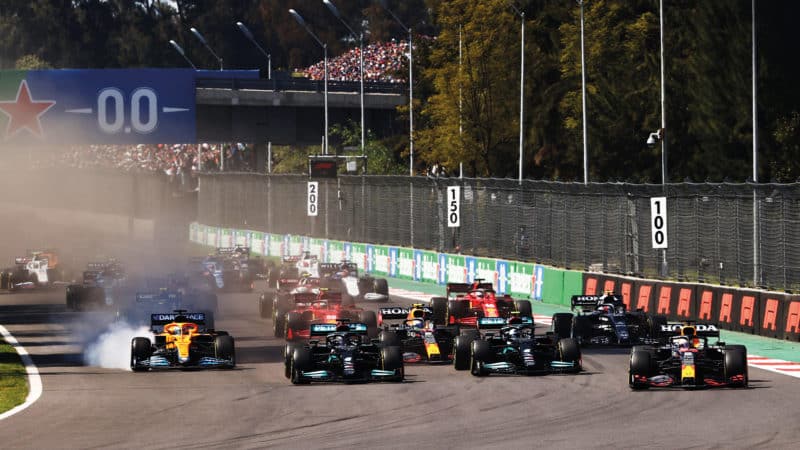
Bottas may have nabbed pole ahead of Hamilton, but Verstappen steamed into the lead before Turn 1 in Mexico, going on to nab his ninth win of the season
Verstappen was otherwise utterly dominant, the Red Bull’s greater downforce extra valuable in the thin air of Mexico City’s 2200m altitude.
Pérez was able to pressure Hamilton’s second place hard into the race’s late stages, getting the enthusiastic Mexican crowd fantastically animated and vocal – “I could actually hear them in the car,” claimed Pérez – but just fell short at the end. He’d been the last of the lead trio to pit and so had led on the road for a few laps – and this too sent the crowd into ecstasy.
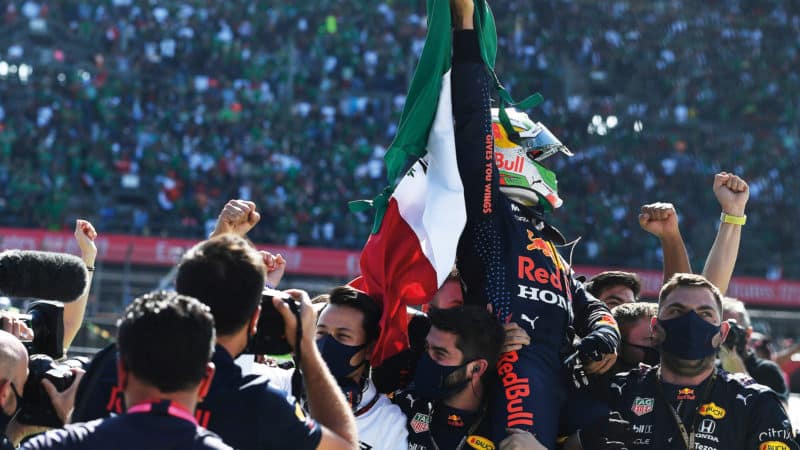
A hero at home: Sergio Pérez celebrates his Mexico City podium
A week later, Interlagos was hosting the third of 2021’s experimental sprint race formats for the São Paulo Grand Prix (the naming reflecting the fact that the local government, not the federal, was funding the event). With neither rear tyre deg nor downforce limitations being so severely punished here, Mercedes was once more in the heady form it was enjoying pre-Austin – only more so. It had chosen this race in which to install Hamilton’s fifth internal combustion engine of the season, giving him a five-place grid drop on Sunday. It also gave him a significant power boost and in qualifying for the sprint race he qualified 0.438sec faster than second-fastest Verstappen around a short lap. It was by far the most dominant qualifying performance of either team during the season to date – greater than Red Bull in Austria or Mercedes at Monza, by a significant margin.
It intensified Red Bull’s suspicions about what Mercedes might be doing with its rear wing. The FIA made an apparently routine test of Hamilton’s wing post-qualifying on the Friday and found that its DRS gap was 0.2mm too wide at one end. The discrepancy could not even begin to explain the devastating pace, but it led to him being disqualified from qualifying and so he started the sprint race from the back. Bottas, opting for soft tyres to the mediums of Verstappen, accelerated straight into the lead – and stayed there. Hamilton scythed through the pack and in just 24 laps went from 20th to fifth. Another couple of laps and he could probably have dispatched Pérez and Sainz, too.
“Verstappen implored Red Bull to bring him in for an early second stop”
This put Bottas on pole for the grand prix alongside Verstappen, with Sainz’s Ferrari and Pérez’s Red Bull-Honda on row two. With his five-place grid penalty, Hamilton would start from 10th. Yet even from second and 10th respectively, Verstappen and Hamilton still ended up fighting out this race in yet another of their epic contests.
Verstappen was straight into the lead after hanging Bottas out to dry on the Senna Esses kerbs, this so compromising the Merc’s run onto the back straight that Pérez was able to slipstream past to put Red Bull 1-2. Hamilton was already up to sixth by the end of the opening lap and picked off the two Ferraris on subsequent laps before being allowed through by Bottas. A safety car then evaporated the gap between Pérez and Hamilton. Their dice lasted until Hamilton finally found a way through Pérez’s defences on the 19th lap of 71. Hamilton is a great favourite with the Brazilian crowd and their cheers rang through the place and there was a sense of something extraordinary unfolding as Hamilton set his sights next on Verstappen.
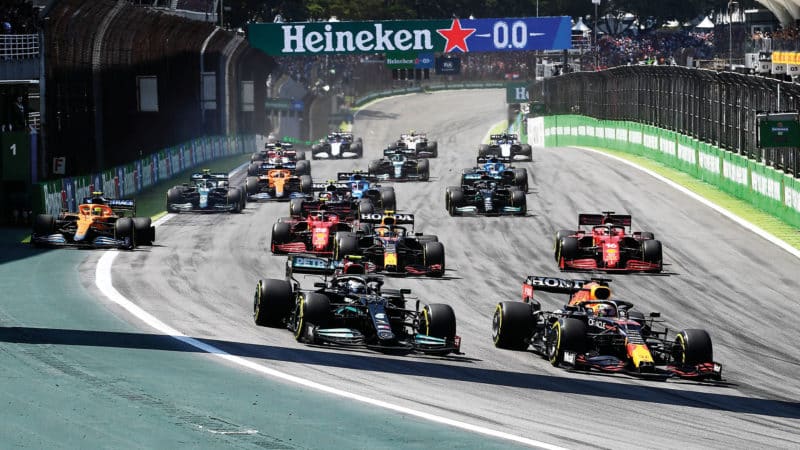
A Mercedes and a Red Bull neck-and-neck has been a familiar sight this season, but Hamilton starting so far back hasn’t been. Not that his combined 25-place grid drop in Brazil made much of a difference
Because this was another two-stop tyre deg race (not to the extreme of Austin, and working the front tyres even more than the rear, but similar), the devastating pace of the Merc seen in qualifying couldn’t simply be unleashed. With each driving to their tyre temperatures, the gap between them remained static for all of the first medium-shod stint at around 4sec. Mercedes brought Hamilton in to pressure Red Bull into doing the same with Verstappen. That closed the gap to around 1.5sec for the middle stint, ratcheting up the tension, but still with neither yet prepared to make a break for it, so crucial was it not to overwork the tyres.
“There was no need for Lewis to get involved in any wheel banging”
Verstappen – noting that at the pace he was driving his tyres to, Hamilton was able to comfortably keep up – was very concerned that he was going to lose track position to a Mercedes undercut. He was imploring the team to bring him in for the second stop as early as possible. That was lap 40 – and in hindsight it was too early. A final stint of 31 laps was too much for the Red Bull’s tyre usage. Hamilton, in a Mercedes which was much gentler on the rubber at this pace (which is how its performance advantage played out in race conditions) came in three laps later and immediately went on the attack as Verstappen tried to manage his rubber. The crowd began to stir again as Hamilton several times got in the Red Bull’s DRS zone and feigned this way and that. Like a boxer working at tiring his opponent, Hamilton was just wearing Verstappen’s resources down. The longer the stint went on, the less front-tyre grip Verstappen had through the Senna Esses and Turn 2 and Hamilton could sense that his opportunity was going to come into Turn 4. He was upon him on the 48th lap and marginally ahead but on the outside as they approached that corner. Verstappen let his car run out wide and onto the Tarmac run-off, obliging Hamilton to do the same to avoid a collision. The stewards looked at it and might ordinarily have awarded a time penalty, but on this occasion let it go.

Verstappen and Red Bull were firmly shaded by Hamilton and Mercedes in Brazil. With three races left, Max leads by just 14 points
Hamilton remained calm. There was no need to get involved in Verstappen’s invitation to bang wheels; he was faster and that advantage was only building as the Red Bull’s tyres deteriorated further.
So Hamilton regrouped and kept the pressure on. He finally made the move work earlier on the straight, getting the pass done before they’d even arrived at the corner. Verstappen’s weaving across the track in defence didn’t deter Hamilton and succeeded only in earning the Red Bull driver a black-and-white warning flag.
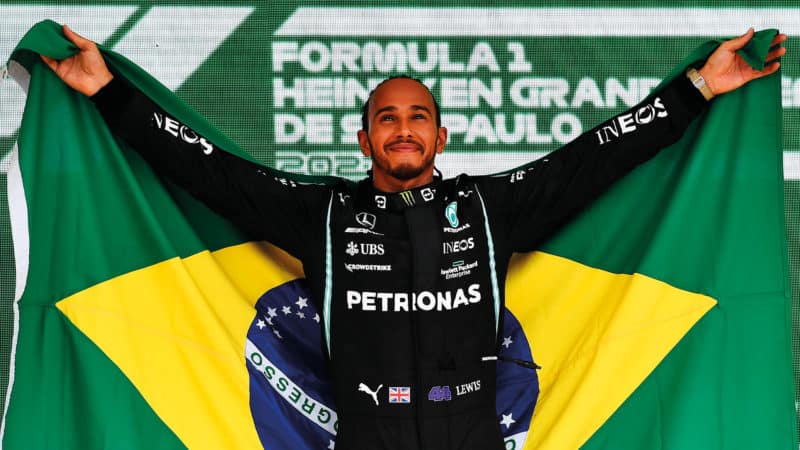
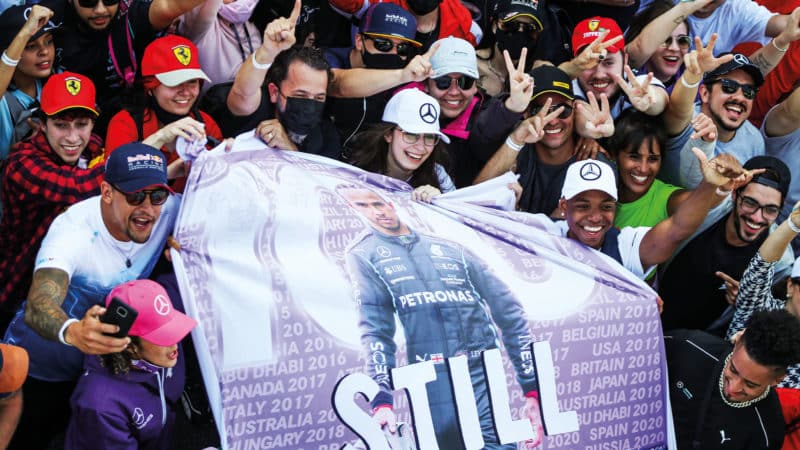
The crowd at São Paulo were firmly out in support of Hamilton, who wore a Senna-themed helmet
It was the crescendo of a truly remarkable Hamilton performance, but one aided by a Mercedes which was very much better suited to the demands of the day.
He cannot remember all of his 100+ grand prix victories, but Hamilton reckoned this was, “one of the very best, maybe even the best…”
